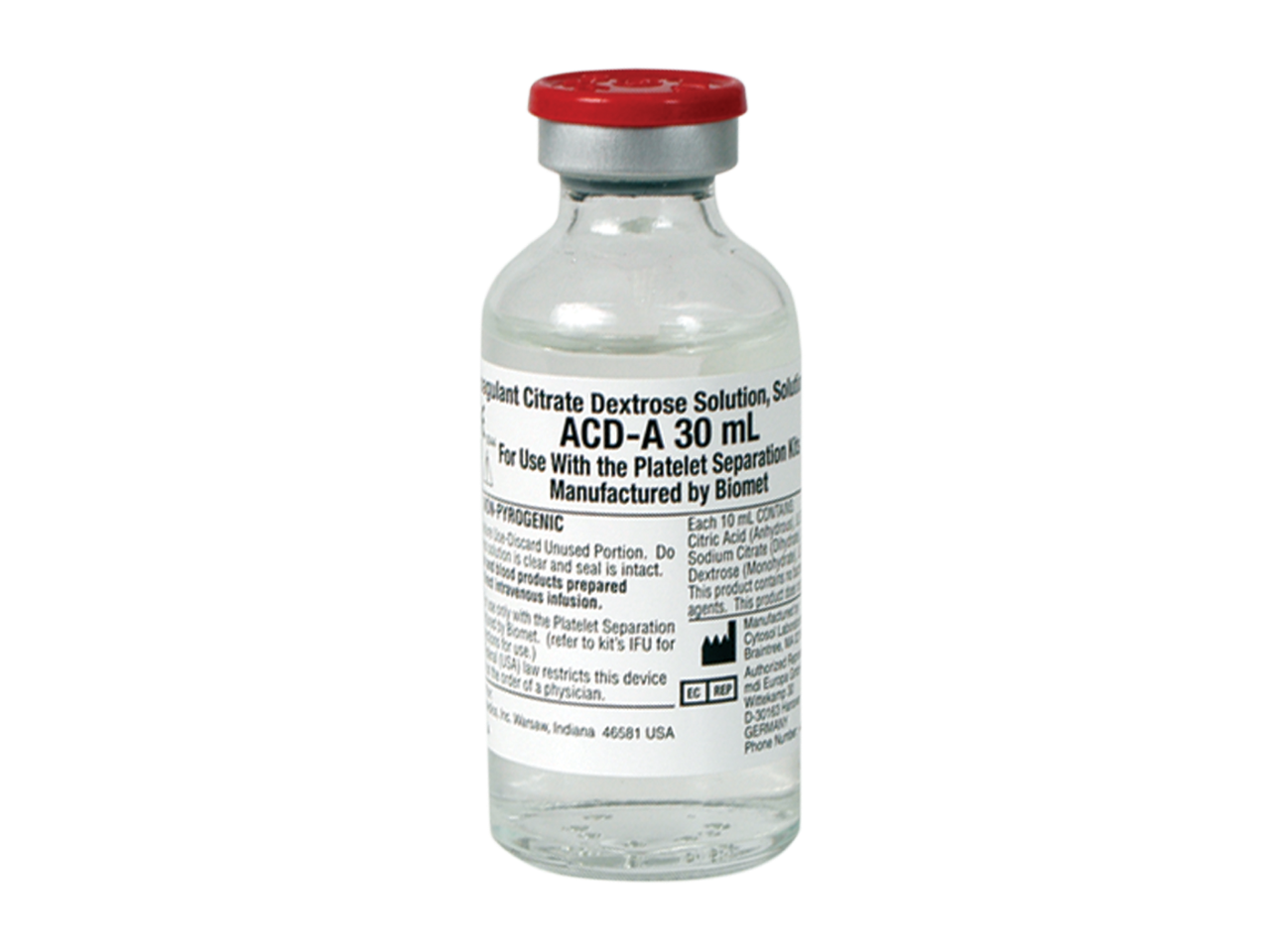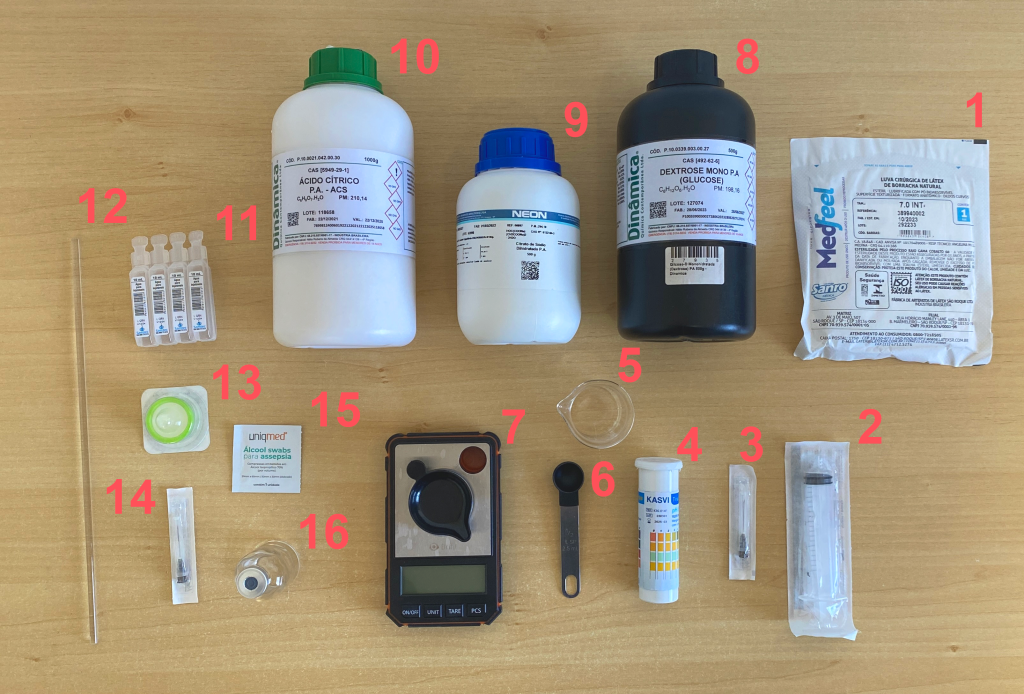Before getting started here, check out our comparative analysis of anticoagulants!
ACD-A (Acid Citrate Dextrose Solution A) is a widely used anticoagulant in blood collection and preservation, known for its efficacy in preventing clotting by chelating calcium ions. This solution, composed primarily of citric acid, sodium citrate, and dextrose, plays a crucial role in maintaining the viability and functionality of collected blood components. Specifically, ACD-A has significant in vivo benefits for Platelet-Rich Plasma (PRP) therapy, as it preserves the platelets’ integrity and activity, enhancing their regenerative properties when reintroduced into the body. This makes ACD-A indispensable in medical treatments that utilize PRP for accelerating tissue repair and promoting healing.
What is ACD-A really?
ACD-A (Acid Citrate Dextrose Solution A) is a specialized anticoagulant solution used primarily in blood collection and preservation. The formulation of ACD-A includes the following components:
- Citric Acid Monohydrate (C₆H₈O₇·H₂O): 8.0 grams per liter
- Sodium Citrate Dihydrate (Na₃C₆H₅O₇·2H₂O): 22.0 grams per liter
- Dextrose Monohydrate (D-Glucose, C₆H₁₂O₆·H₂O): 24.5 grams per liter
These ingredients are dissolved in sterile water to make up the final solution. The solution should have an expected pH of between 4.5 – 5.5.
Note that if using an anhydrous citric acid the concentration would then be 7.3g/L of citric acid.
Function and Mechanism
- Citric Acid and Sodium Citrate: These components work together to chelate calcium ions in the blood. Calcium is a crucial factor in the blood clotting cascade, and by binding to calcium, citrates effectively prevent clotting.
- Dextrose: This serves as a source of energy for cells, particularly red blood cells and platelets, helping to maintain their viability and functionality during storage.
In Vivo Benefits for PRP (Platelet-Rich Plasma)
When used in the preparation of Platelet-Rich Plasma (PRP), ACD-A offers specific in vivo benefits:
- Preservation of Platelet Function: ACD-A helps maintain the platelets’ integrity and functional properties, which is crucial for the therapeutic efficacy of PRP.
- Enhanced Regenerative Potential: By preserving platelet activity, ACD-A ensures that the growth factors and other bioactive molecules released by platelets remain potent, thus improving tissue repair and healing processes when PRP is administered to patients.
Practical Use
In practical terms, ACD-A is mixed with blood in a specific ratio during collection to prevent coagulation and maintain the quality of the collected blood components. This makes it invaluable in various medical applications, including blood transfusions, apheresis, and PRP therapies, where maintaining the functional integrity of blood cells and platelets is essential.
Common ratios of ACD-A to whole blood for use in PRP are between 1:7 and 1:9.
Formulating an ACD-A Solution

READ BEFORE CONTINUING: Ensure that all glassware and stainless steel tools used including glass beakers, measuring spoons, scale cups, or any other item that comes into contact with any chemical or product is depyrogenated according to our Advanced Depyrogenation and Sterilization protocol.
Formulating ACD-A (Acid Citrate Dextrose Solution A) is a meticulous process that requires precise measurement and careful handling of its components to ensure its efficacy as an anticoagulant. It is important to note that a prerequisite knowledge of chemistry and laboratory procedures is essential for anyone attempting to formulate ACD-A. This guide does not cover basic laboratory safety protocols or the fundamental chemical knowledge required. In the following sections, we will detail the step-by-step process for formulating ACD-A, highlighting the necessary materials, equipment, and procedural steps to achieve a consistent and effective solution. Whether you are preparing ACD-A for laboratory use, clinical applications, or research purposes, these instructions will guide you through the process, ensuring accuracy and safety. However, please ensure that you fully understand the risks and have the appropriate expertise before proceeding.
Required Materials and Equipment

- Sterile Gloves
- Use: Sterile gloves for handling sterile components.
- Surgical Mask
- Use: Maintain sterility of workspace.
- 20 mL Luer Lock Syringe
- Use: Preparing the ACD-A solution by mixing sterile water.
- 25 x 0.70 mm (22G x 1) Needle
- Use: Extracting sterile water from ampules.
- pH Test Strips
- Use: Verifying the pH level of the prepared ACD-A solution.
- 50 mL Glass Beaker
- Use: Mixing all constituent components.
- Teaspoon
- Use: Transferring chemicals.
- Analytical Scale
- Use: Weighing all constituent components.
- Note: Requires accuracy to 0.001 grams.
- USP Grade Dextrose Monohydrate (D-Glucose, C₆H₁₂O₆·H₂O)
- Use: Constituent component of ACD-A.
- USP Grade Sodium Citrate Dihydrate (Na₃C₆H₅O₇·2H₂O)
- Use: Constituent component of ACD-A.
- USP Grade Citric Acid Monohydrate (C₆H₈O₇·H₂O)
- Use: Constituent component of ACD-A.
- 40 mL of Sterile Water for Injection
- Use: Preparing the ACD-A solution and priming the syringe filter.
- Glass Stir Rod
- Use: Stirring the constituents in the beaker to a homogeneous mixture.
- 30 mm Sterile Syringe Filter, PES Membrane, 0.22 Microns
- Use: Filtering and sterilizing the ACD-A solution before adding it to the sterile 30 mL vial.
- Note: A 0.22 µm filter is sufficient to remove bacteria and particulates, but does not eliminate cytotoxins, endotoxins, or pyrogens. For in vivo applications, a polyethersulfone (PES) membrane is typically used due to its biocompatibility and low protein-binding properties. Glassware and chemicals must be sterile.
- 25 x 0.70 mm (22G x 1) Needle
- Use: Filling the ACD-A vial with the sterilized ACD-A solution.
- Sterile Wipe
- Use: Cleaning the ACD-A vial’s rubber stopper before adding the solution.
- ACD-A Storage Vial, 30 mL
- Use: Storing the ACD-A anticoagulant solution.
- Note: The vial must be sterilized and free of cytotoxins, endotoxins, and pyrogens. Use proper sterilization techniques.
Watch the Instruction Video
In this video, the process of formulating ACD-A step-by-step is revealed. Watching this video will give you a visual understanding of each step, ensuring you can follow along with ease.
Instructions
Note: All glassware used should be properly sterilized beforehand via dry heat depyrogenation at 250°C for thirty minutes prior to use.
- Weigh 0.660 grams of Sodium Citrate Dihydrate, and add to the beaker.
- Weigh 0.240 grams of Citric Acid Monohydrate, and add to the beaker.
- Weigh 0.735 grams of Dextrose Monohydrate, and add to the beaker.
- Prime the 20 mL syringe by actuating the plunger a couple times. This will help free up the plunger.
- Proceed to use the 22G needle to draw out 30 mL of sterile water from the ampules and add this water to the beaker.
- Note: Sterile water is preferred as it’s free of cytotoxins, endotoxins, and pyrogens that could cause an adverse reaction for in vivo use.
- Once the water has been added, stir the mixture well into a homogenous solution. Some crystals will remain on the bottom and may be crushed up with the end of the stir rod.
- Use a pH meter to measure the pH of the solution. Adjust the pH to between 4.5 and 5.5 using small amounts of citric acid or sodium citrate solution as needed. However, if the concentration ratios were followed, the solution should be already adjusted.
- Note: Drop some of the solution onto the test strip rather than dipping the test strip into the solution, to prevent contamination.
- Use the sterile wipe to sanitize the rubber stopper of the 30 mL storage vial.
- Prepare the syringe filter by attaching it to a sterile 22G needle, being careful not to contaminate the sterile side of the filter.
- Using the remaining 10 mL ampule of sterile water, draw the water into a 20 mL syringe. Use this water to prime the sterile filter by pushing it through the filter into a discard container. This step ensures that any loose fibers or particulates on the sterile side of the filter are flushed out and do not contaminate the final solution.
- Cap the sterile needle/filter assembly and disconnect from the syringe. Set aside.
- Using the 20 mL syringe, draw up the ACD-A solution from the beaker. Note that 10 mL of the solution will remain in the beaker and will need to be processed in a subsequent step.
- Attach the sterile needle/filter assembly to the 20 mL syringe and proceed to fill the 30 mL vial with the ACD-A solution.
- Once the 20 mL syringe is empty, disconnect the syringe from the needle/filter assembly, leaving the assembly in the rubber stopper of the vial.
- Draw up the remaining ACD-A solution from the beaker using the syringe. Reattach the syringe to the needle/filter assembly without removing it from the rubber stopper, and fill the vial with the remainder of the solution.
- Verify the solution within the vial is free of particulates.
- Clean the vial and label vial with the contents and the date of formulation.
Final Checks and Storage
Ensure the solution is clear and free of particulates. It is recommended that the solution be stored at ambient room temperature, 24 °C (75 °F); however, the solution can be stored between 15 °C (59 °F) and 30 °C (86 °F). Protect from freezing and exposure to excessive heat should be minimized. ACD-A should be used within thirty days of formulation.
The limitation on storage duration is primarily due to concerns about the stability and sterility of the solution over time. Components like citric acid, sodium citrate, and dextrose can degrade or react over extended periods, potentially reducing the solution’s effectiveness as an anticoagulant. Moreover, maintaining a sterile environment is crucial to prevent microbial contamination, which is harder to guarantee over longer storage times.
References
- Nakamura, M., Nakata, K., & Kawase, T. (2020). A comparative study of the effects of anticoagulants on pure platelet-rich plasma quality and potency. Biomedicines, 8(3), 42. https://doi.org/10.3390/biomedicines8030042
- Masayuki, N., & Koh, N. (2020). Comparative analysis of anticoagulants in platelet-rich plasma preparation. Journal of Regenerative Medicine, 10(2), 150-160.
- Pignatelli, P., & Lei, V. (2009). Effects of anticoagulants on platelet function and quality of PRP. Blood Journal, 124(20), 325-330.
- Högman, C. F., Meryman, H. T., & Ericsson, J. L. (1996). Long-term preservation of red cells at 4 degrees C in a new additive solution. Transfusion, 36(8), 752-758. http://www.ncbi.nlm.nih.gov/pubmed/8823453
- Lindsell, C. J., Goins, W. P., Chung, K. W., & et al. (1988). Stability of ACD-A anticoagulated blood for use in platelet function tests. Clinical Chemistry, 34(10), 2023-2029. http://www.ncbi.nlm.nih.gov/pubmed/3130694
- Shah, N., & Loo, M. (2014). Characterization of Platelet-Rich Plasma in the Hemophilia A Mouse. Blood, 124(20). http://www.bloodjournal.org/content/bloodjournal/suppl/2014/11/04/blood-2014-06-585083.DC1/blood-2014-06-585083-1.pdf?sso-checked=true
- Papayannopoulou, T., & Nakamoto, B. (2003). Control of erythropoiesis in vitro. Annals of Oncology, 14(suppl_1), i29-i35. http://annonc.oxfordjournals.org/content/14/suppl_1/i29.full.pdf
- Zimmer Biomet. (2020). ACD-A Anticoagulant Citrate Dextrose Solution, Solution A. https://www.zimmerbiomet.com/content/dam/zb-corporate/en/products/products/pharmaceuticals/acd-a-anticoagulant-citrate-dextrose-solution-solution-a/ACD-A-FL9350-0120.pdf


Leave a Reply